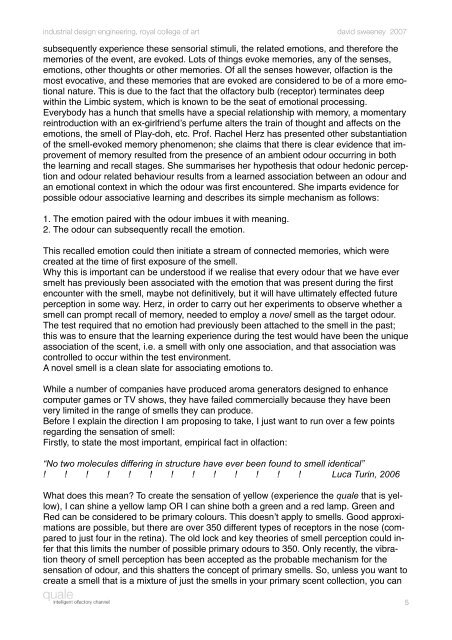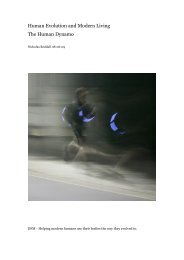industrial design engineering, royal college of art david sweeney ...
industrial design engineering, royal college of art david sweeney ...
industrial design engineering, royal college of art david sweeney ...
You also want an ePaper? Increase the reach of your titles
YUMPU automatically turns print PDFs into web optimized ePapers that Google loves.
<strong>industrial</strong> <strong>design</strong> <strong>engineering</strong>, <strong>royal</strong> <strong>college</strong> <strong>of</strong> <strong>art</strong> <strong>david</strong> <strong>sweeney</strong> 2007<br />
subsequently experience these sensorial stimuli, the related emotions, and therefore the<br />
memories <strong>of</strong> the event, are evoked. Lots <strong>of</strong> things evoke memories, any <strong>of</strong> the senses,<br />
emotions, other thoughts or other memories. Of all the senses however, olfaction is the<br />
most evocative, and these memories that are evoked are considered to be <strong>of</strong> a more emotional<br />
nature. This is due to the fact that the olfactory bulb (receptor) terminates deep<br />
within the Limbic system, which is known to be the seat <strong>of</strong> emotional processing.<br />
Everybody has a hunch that smells have a special relationship with memory, a momentary<br />
reintroduction with an ex-girlfriend’s perfume alters the train <strong>of</strong> thought and affects on the<br />
emotions, the smell <strong>of</strong> Play-doh, etc. Pr<strong>of</strong>. Rachel Herz has presented other substantiation<br />
<strong>of</strong> the smell-evoked memory phenomenon; she claims that there is clear evidence that improvement<br />
<strong>of</strong> memory resulted from the presence <strong>of</strong> an ambient odour occurring in both<br />
the learning and recall stages. She summarises her hypothesis that odour hedonic perception<br />
and odour related behaviour results from a learned association between an odour and<br />
an emotional context in which the odour was first encountered. She imp<strong>art</strong>s evidence for<br />
possible odour associative learning and describes its simple mechanism as follows:<br />
1. The emotion paired with the odour imbues it with meaning.<br />
2. The odour can subsequently recall the emotion.<br />
This recalled emotion could then initiate a stream <strong>of</strong> connected memories, which were<br />
created at the time <strong>of</strong> first exposure <strong>of</strong> the smell.<br />
Why this is important can be understood if we realise that every odour that we have ever<br />
smelt has previously been associated with the emotion that was present during the first<br />
encounter with the smell, maybe not definitively, but it will have ultimately effected future<br />
perception in some way. Herz, in order to carry out her experiments to observe whether a<br />
smell can prompt recall <strong>of</strong> memory, needed to employ a novel smell as the target odour.<br />
The test required that no emotion had previously been attached to the smell in the past;<br />
this was to ensure that the learning experience during the test would have been the unique<br />
association <strong>of</strong> the scent, i.e. a smell with only one association, and that association was<br />
controlled to occur within the test environment.<br />
A novel smell is a clean slate for associating emotions to.<br />
While a number <strong>of</strong> companies have produced aroma generators <strong>design</strong>ed to enhance<br />
computer games or TV shows, they have failed commercially because they have been<br />
very limited in the range <strong>of</strong> smells they can produce.<br />
Before I explain the direction I am proposing to take, I just want to run over a few points<br />
regarding the sensation <strong>of</strong> smell:<br />
Firstly, to state the most important, empirical fact in olfaction:<br />
“No two molecules differing in structure have ever been found to smell identical”<br />
Luca Turin, 2006<br />
What does this mean? To create the sensation <strong>of</strong> yellow (experience the quale that is yellow),<br />
I can shine a yellow lamp OR I can shine both a green and a red lamp. Green and<br />
Red can be considered to be primary colours. This doesn’t apply to smells. Good approximations<br />
are possible, but there are over 350 different types <strong>of</strong> receptors in the nose (compared<br />
to just four in the retina). The old lock and key theories <strong>of</strong> smell perception could infer<br />
that this limits the number <strong>of</strong> possible primary odours to 350. Only recently, the vibration<br />
theory <strong>of</strong> smell perception has been accepted as the probable mechanism for the<br />
sensation <strong>of</strong> odour, and this shatters the concept <strong>of</strong> primary smells. So, unless you want to<br />
create a smell that is a mixture <strong>of</strong> just the smells in your primary scent collection, you can<br />
5



